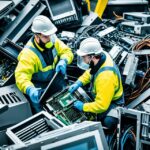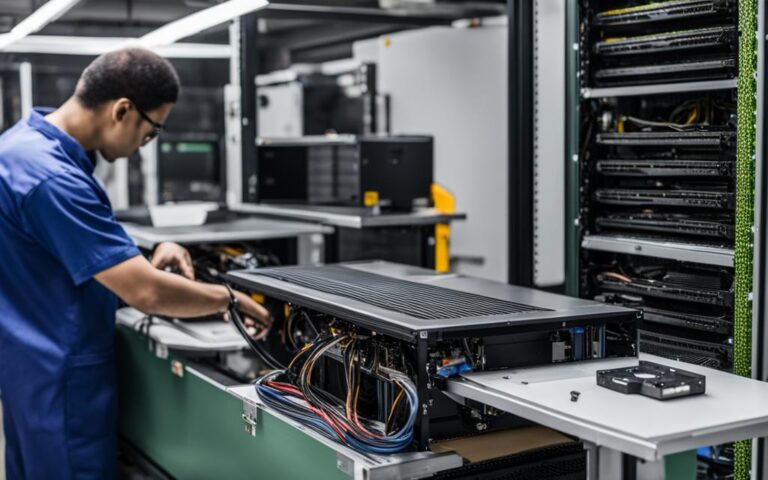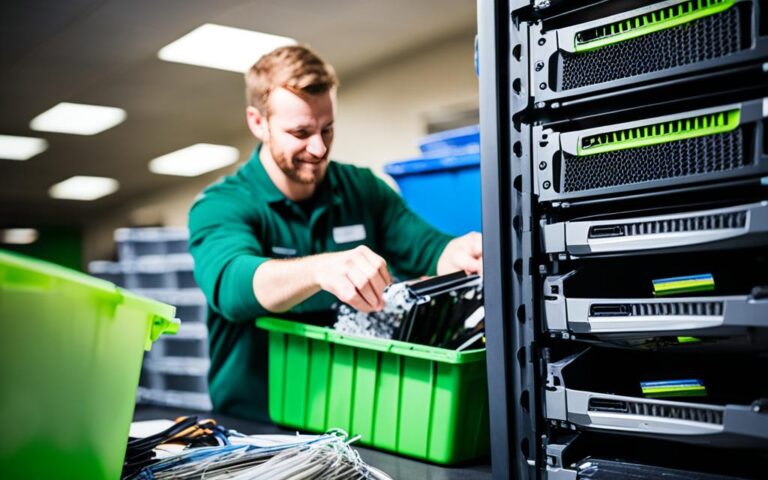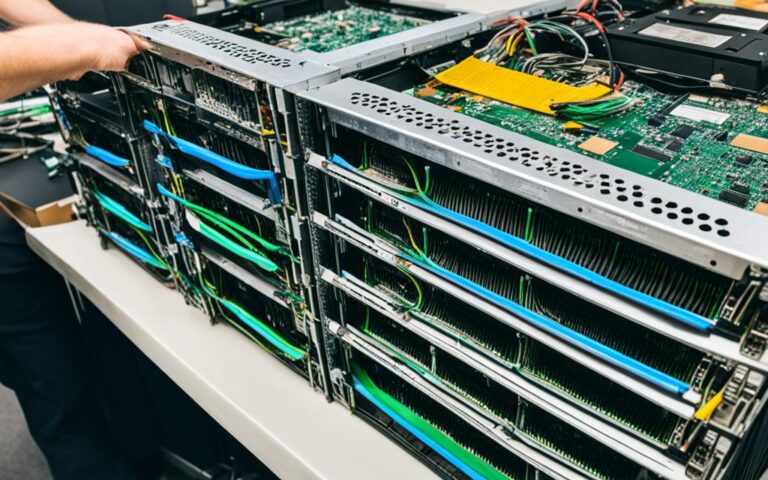Server Recycling: Opportunities for Public-Private Partnerships
In today’s rapidly evolving technological landscape, responsible disposal of servers and network equipment is crucial for data security and resource management. Server recycling initiatives have emerged as a sustainable solution to address the growing concerns of electronic waste (e-waste) and its environmental impact.
Server recycling involves the safe and efficient dismantling, reusing, and disposing of servers and network equipment. It aims to recover valuable materials, minimize the environmental footprint, and ensure data privacy through advanced data wiping techniques. To fully harness the potential of server recycling, the collaboration of public and private sectors through public-private partnerships is essential.
The Importance of Data Security in Server and Network Recycling
When it comes to server and network recycling, data security stands as a critical pillar in safeguarding sensitive information. Proper measures must be taken to prevent unauthorized access to data, ensuring the protection of valuable assets. This section explores the significance of data security in server and network recycling and highlights the advanced data wiping techniques employed to achieve this objective.
Data security serves as the first line of defense against potential breaches and unauthorized data retrieval. A comprehensive approach to data wiping is crucial to permanently erase all stored information, making it irretrievable by unauthorized users or malicious actors.
Advanced data wiping techniques, including military-grade software, play a pivotal role in ensuring comprehensive data erasure. These techniques adhere to international security standards such as the renowned National Institute of Standards and Technology (NIST) publication 800-88.
“With the adoption of military-grade software meeting international security standards like NIST 800-88, all data is permanently deleted, leaving no trace of information that could be exploited by unauthorized individuals.”
By implementing these data wiping techniques, organizations can confidently recycle their servers and network equipment without compromising the privacy and security of their sensitive data.
The image above visually represents the importance of data security in server and network recycling. It serves as a reminder that proper data wiping techniques are essential to ensuring the privacy and protection of valuable information.
Data Wiping Techniques in Server and Network Recycling
Let’s dive deeper into the various data wiping techniques employed within the server and network recycling process:
| Technique | Description |
|---|---|
| Gutmann Method | A data wiping technique that involves overwriting data with a series of patterns, ensuring thorough erasure. |
| Secure Erase | A method that leverages the built-in ATA command to erase data securely from storage devices. |
| DoD 5220.22-M | An approach specified by the U.S. Department of Defense, involving multiple passes of overwriting data to ensure complete erasure. |
| Physical Destruction | A method that physically destroys storage devices, rendering the data inaccessible. |
These techniques, when implemented correctly, provide an essential layer of data security in the server and network recycling process, ensuring the peace of mind of organizations and individuals alike.
Material Recovery and Reusability in Server and Network Recycling
In the process of server and network recycling, advanced sorting technologies such as spectrometry and magnetic separation are utilized to recover valuable materials that can be reused. These materials include gold, copper, and rare earth elements, which are essential components of electronic devices.
By implementing these advanced sorting techniques, the recycling industry can not only recover valuable materials, but also reduce the need for extracting virgin resources, minimizing environmental impact and promoting a more sustainable circular economy.
The recovery of rare earth elements, in particular, is of great significance. Rare earth elements are crucial in the production of various electronic components due to their unique properties. However, the extraction of these elements from the earth is both environmentally damaging and resource-intensive. Server and network recycling provides an opportunity to extract and reuse these elements, reducing the demand for new extraction and minimizing the associated environmental risks.
To illustrate the impact of material recovery and reusability in server and network recycling, here is a table showcasing the valuable materials that can be recovered along with their potential reuse:
| Material | Potential Reuse |
|---|---|
| Gold | Manufacturing of new electronic components |
| Copper | Production of electrical wiring and connectors |
| Rare Earth Elements | Creation of magnets, batteries, and energy-efficient devices |
By recovering and reusing these valuable materials, server and network recycling not only reduces the environmental impact of electronic waste but also contributes to the conservation of limited resources.
Eco-Friendly Disposal Methods in Server and Network Recycling
As environmental concerns grow, companies are embracing innovative and eco-friendly disposal methods in server and network recycling. The goal is not only to minimize the environmental impact of electronic waste (e-waste) but also to set an example for other industries to follow.
The Use of Biodegradable Materials
One of the key eco-friendly methods in server and network recycling is the incorporation of biodegradable materials. These materials, such as bioplastics and bio-composites, have the ability to break down naturally over time, reducing the accumulation of non-biodegradable waste in landfills. By adopting biodegradable components in server and network equipment, companies can contribute to a more sustainable and environmentally friendly approach to disposal.
Eco-Friendly Solvents for Non-Recyclable Components
Another important aspect of eco-friendly disposal methods is the use of environmentally friendly solvents for components that cannot be recycled. These solvents are designed to minimize harm to the environment while effectively removing hazardous substances from the equipment. By opting for eco-friendly solvents, companies can ensure that even the disposal process aligns with their commitment to sustainability.
“By adopting biodegradable components and eco-friendly solvents in server and network recycling, companies can lead the way in reducing the environmental impact of e-waste and promoting a greener future.”
Companies that prioritize eco-friendly disposal methods in their server and network recycling practices demonstrate their commitment to environmental stewardship. They not only reduce the carbon footprint associated with e-waste disposal but also contribute to the development of more sustainable practices in the industry. By setting a precedent for other sectors, companies can inspire a broader movement towards responsible and eco-friendly waste management.
The Importance of Collaboration and Awareness
Adopting eco-friendly disposal methods requires collaboration between businesses, recyclers, and regulatory bodies. By working together, stakeholders can develop standardized practices, share best practices, and drive innovation in the field of server and network recycling. Additionally, raising awareness among consumers and the general public about the importance of proper e-waste disposal and the benefits of eco-friendly methods is crucial for creating a sustainable future.
Eco-friendly disposal methods in server and network recycling provide a blueprint for businesses to follow in addressing the environmental challenges associated with e-waste. By prioritizing biodegradable materials and eco-friendly solvents, companies can significantly reduce their impact on the planet while inspiring positive change in the industry.
Automation and AI in E-Waste Management
In today’s ever-evolving world, automation and artificial intelligence (AI) have emerged as game-changers in the field of e-waste management. These cutting-edge technologies are revolutionizing the recycling process, offering a more efficient and reliable way to manage electronic waste. By harnessing the power of automation and AI, recycling facilities can optimize their operations, minimize human error, and improve overall sustainability.
One of the key applications of automation and AI in e-waste management is in the sorting and separation of different materials. Automated sorting lines equipped with advanced AI algorithms can quickly and accurately identify various components, such as circuit boards, metals, plastics, and rare earth elements. This allows for efficient material recovery, reducing the reliance on raw materials and promoting a more sustainable circular economy.
“Automation and AI are transforming the way we handle e-waste, enabling us to extract valuable resources with precision and speed,” says Dr. Emma Greenfield, a leading expert in sustainable waste management.
“These technologies not only enhance the efficiency of the recycling process but also contribute to the reduction of e-waste globally, mitigating the environmental impact of electronic devices.”
The Benefits of Automation and AI in E-Waste Management
The integration of automation and AI brings numerous advantages to the field of e-waste management. Here are some key benefits:
- Increased Efficiency: Automated sorting lines can process large volumes of e-waste more quickly and accurately than manual labor, significantly accelerating the recycling process.
- Enhanced Resource Recovery: AI algorithms can identify valuable materials that would otherwise be overlooked, maximizing the recovery of valuable elements like gold, copper, and other scarce resources.
- Reduced Environmental Impact: By automating the sorting and separation process, the recycling industry can effectively reduce the environmental footprint associated with e-waste disposal, promoting a greener and more sustainable future.
- Minimized Human Error: Automation eliminates the risk of human error, ensuring consistent and precise sorting of materials, leading to higher-quality recycled products.
| Key Benefits of Automation and AI in E-Waste Management | Explanation |
|---|---|
| Increased Efficiency | Automated sorting lines accelerate the recycling process, enhancing productivity and reducing turnaround time. |
| Enhanced Resource Recovery | The use of AI enables the identification and extraction of valuable materials, maximizing resource utilization and reducing the need for virgin resources. |
| Reduced Environmental Impact | Automation and AI help minimize waste generation, promote responsible recycling, and contribute to the conservation of natural resources. |
| Minimized Human Error | By eliminating human involvement, the risk of errors in the sorting and separation process is significantly reduced, ensuring higher-quality recycled products. |
As automation and AI continue to evolve, we can expect even greater advancements in e-waste management. These technologies hold immense potential for transforming the industry and establishing a more sustainable future for all.
Regulatory Compliance and Certification in Server and Network Recycling
When it comes to server and network recycling, regulatory compliance and certification are vital factors to consider. By selecting a recycling company that prioritizes regulatory compliance and holds relevant certifications, businesses and data centers can ensure that their electronic waste is disposed of responsibly and securely, minimizing environmental impact and protecting sensitive data.
One significant certification to look for is ISO 14001, an internationally recognized standard for environmental management systems. A company with ISO 14001 certification has demonstrated its commitment to reducing its environmental footprint and implementing effective waste management practices.
Another important certification is the e-Stewards certification, which emphasizes responsible recycling and data security. Recycling companies certified with e-Stewards adhere to strict guidelines for proper material disposal, ensuring that hazardous substances are handled safely and that data privacy is maintained throughout the recycling process.
By partnering with a recycling company that has undergone the rigorous certification process, businesses can have peace of mind knowing that their electronic waste will be handled in compliance with the highest industry standards.
The Benefits of Regulatory Compliance and Certification
By prioritizing regulatory compliance and choosing a certified recycling partner, businesses can reap numerous benefits, including:
- Peace of mind: Regulatory compliance and certification provide assurance that electronic waste will be disposed of responsibly and according to environmental regulations.
- Data protection: Certified recycling companies implement stringent data security measures, ensuring that sensitive information is protected during the recycling process.
- Environmental sustainability: Compliance with environmental regulations and certifications like ISO 14001 demonstrates a commitment to sustainability, contributing to the circular economy by promoting the reuse of valuable materials.
- Brand reputation: Partnering with a certified recycling company showcases a commitment to environmental responsibility and can enhance a business’s reputation among customers, investors, and stakeholders.
By considering regulatory compliance and certification as crucial criteria when selecting a recycling partner, businesses can actively contribute to a sustainable future while protecting their sensitive data.
“Choosing a recycling company that prioritizes regulatory compliance and holds relevant certifications helps businesses align their environmental and security goals, ensuring the responsible disposal of electronic waste while safeguarding sensitive data.”
Comparison of Certifications
| Certification | Focus | Main Benefits |
|---|---|---|
| ISO 14001 | Environmental management | – Demonstration of commitment to environmental sustainability – Reduction of environmental footprint – Compliance with environmental regulations |
| e-Stewards | Responsible recycling and data security | – Assurance of responsible disposal of hazardous materials – Strict data security measures – Compliance with global e-waste import/export regulations |
Conclusion
The role of non-governmental organizations (NGOs) in e-waste management and IT recycling is of paramount importance to our sustainable future. These organizations, through their grassroots initiatives, collaborative efforts, policy advocacy, and global collaborations, are actively addressing the immediate challenges posed by electronic waste. By raising awareness, partnering with governments and corporations, and advocating for policy changes, NGOs have become essential players in the field of e-waste management.
NGOs play a vital role in educating individuals and communities about the environmental and health hazards associated with improper e-waste disposal. By promoting responsible IT recycling practices, NGOs empower individuals to make informed decisions and take collective action towards a more sustainable future.
Furthermore, through their partnerships with governments and corporations, NGOs influence the development of regulations and industry practices that promote environmentally friendly approaches to e-waste management. By collaborating with stakeholders, NGOs ensure that the IT recycling industry operates in compliance with international standards, safeguarding our environment and protecting sensitive data.
In conclusion, NGOs are catalysts for change in e-waste management and IT recycling. Their relentless efforts in raising awareness, forging partnerships, and advocating for policy changes have established them as key drivers in the pursuit of a sustainable future. By actively participating in the initiatives led by these organizations, we can all contribute to the creation of a more sustainable world for generations to come.
FAQ
Why is responsible disposal of servers and network equipment important?
Responsible disposal is crucial for data security and resource management in today’s rapidly evolving technological landscape.
What are some advanced data wiping techniques used in server and network recycling?
Advanced data wiping techniques, such as military-grade software meeting international security standards like NIST 800-88, ensure that all data is permanently deleted and irretrievable by unauthorized users.
How does server and network recycling contribute to material recovery and reusability?
Server and network recycling use advanced sorting technologies like spectrometry and magnetic separation to recover valuable materials such as gold, copper, and rare earth elements, which can then be reused in the manufacturing of new electronic products.
What are some eco-friendly disposal methods used in server and network recycling?
Companies are exploring the use of biodegradable materials and eco-friendly solvents for components that cannot be recycled, reducing the environmental impact of e-waste and setting a precedent for other industries to follow.
How does automation and AI revolutionize e-waste management?
Automation and AI technologies in e-waste management enable automated sorting lines equipped with AI algorithms to identify and separate different materials with high accuracy, speeding up the recycling process and minimizing human error.
Why is regulatory compliance and certification important in server and network recycling?
Regulatory compliance and certifications like ISO 14001 or e-Stewards ensure that a recycling company adheres to international standards for environmental management and data security, providing peace of mind to businesses and data centers.
What role do NGOs play in e-waste management and IT recycling?
NGOs contribute to e-waste management through grassroots initiatives, collaborative efforts, policy advocacy, and global collaborations. Their work in raising awareness, partnering with governments and corporations, and advocating for policy changes makes them essential players in shaping a more sustainable future.















